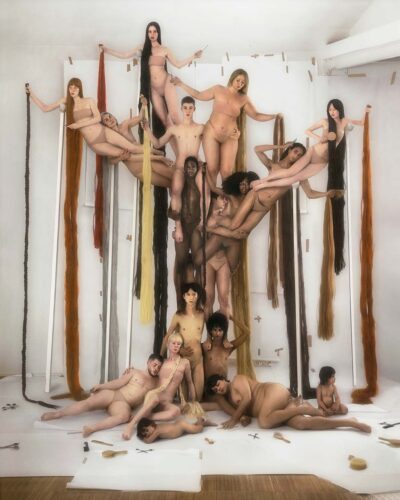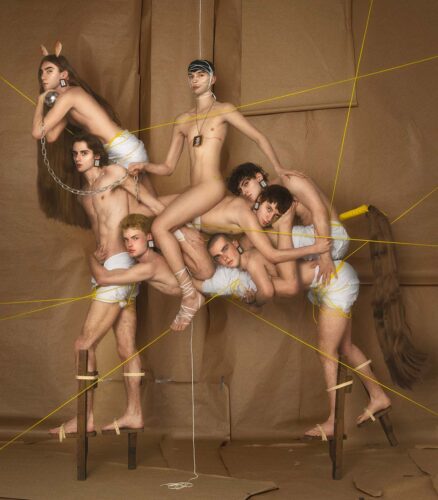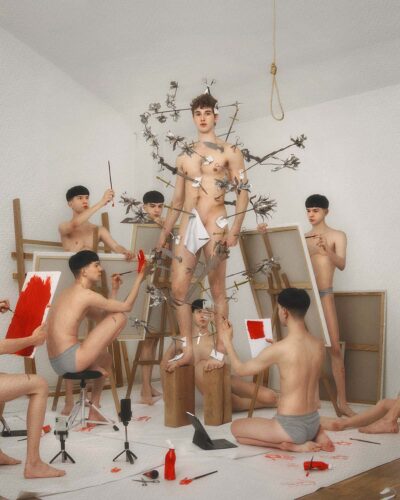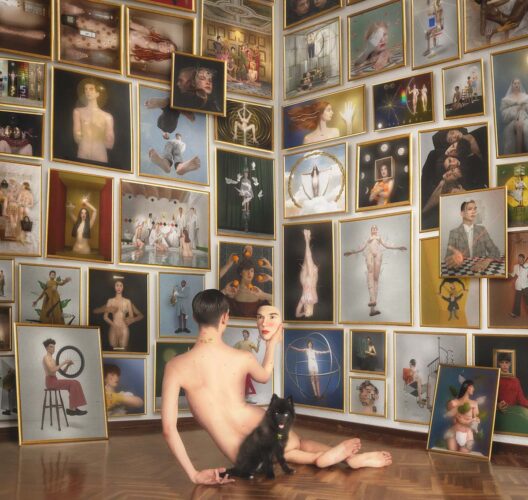EXPOSICIONES
pq hacemos lo q hacemos?
filip custic
6 jul. — 29 sep. 2024
Museo Cerralbo
— Madrid
Organiza
Ministerio de Cultura, Museo Cerralbo, Proyecto SOLO y PHotoESPAÑA
Colabora
PHotoESPAÑA
Horarios de la sede
Martes a sábados 09:30-15:00
Jueves 17:00-20:00
Domingos y festivos 10:00-15:00
Sede
Museo Cerralbo
Ventura Rodríguez, 17
Mapa
Las paredes del Museo Cerralbo están lejos de ser las superficies níveas, livianas y sin límites a las que acostumbran los espacios expositivos contemporáneos. Es en este lugar, articulado por cientos de voces congeladas en lienzos, bustos, esculturas, medallones y armarios, donde filip custic actúa.
Sobre los muros del museo, el artista ofrece un itinerario acelerado por su pasado, planteando una exposición retrospectiva que recorre su producción. filip custic se refleja entonces sobre las paredes y, recordando los pasos ya andados, vuelve a rascarse las heridas que surgieron en el trayecto. Sus composiciones neo-barrocas, detallistas y llenas de datos intoxican las salas mientras se camuflan respetuosamente entre el relato del espacio. La historia del lugar, porosa y en movimiento, acoge una obra líquida y afectuosa que se cuela por las rendijas y las cerraduras de un lugar que le da la bienvenida.
Finalmente, la exposición se completa con una pieza de nueva factura. El Salón de Baile del Museo Cerralbo, donde antes sonaba música señorial y repiqueteaban contra el suelo los tacones de los invitados, ahora hospeda la última obra de filip custic: un busto venoso, donde el bronce propio de la efigie se ha licuado para dar vida a otros cuerpos. El artista cuestiona así la pervivencia de las lógicas monumentales y afirma otras formas de hacer.
En esta muestra se reafirma la capacidad de escucha de un museo interesado no solo en su presente y su pasado, sino también en lo contemporáneo y su contexto. El espacio asume la exposición mientras el artista visita, lejos de la lógica del turista, un intersticio lleno de posibilidades.
The walls of the Museo Cerralbo are far from being the snowy-white, light, boundless surfaces that contemporary exhibition spaces tend to offer. This space, articulated by hundreds of voices frozen in canvases, busts, sculptures, medallions and cabinets, is where filip custic is acting.
The artist is offering an accelerated journey through his past on the museum’s walls, with a retrospective that surveys his entire oeuvre. filip custic is thus reflected on the walls, and recalling paths already taken, he once again scratches the wounds he got along the way. His neo-baroque compositions, detailed and brimming with data, intoxicate the galleries while respectfully camouflaging the story of the space. The history of the venue, porous and in motion, is thus harbouring a liquid, affective body of work which seeps in through the chinks and keyholes of a place that welcomes him.
Finally, the exhibition is rounded out with a new piece. The Museo Cerralbo’s Dance Hall, where patrician music used to play and the guests’ heels used to clatter on the floor, now houses filip custic’s latest work: a venous bust where the effigy’s bronze has been liquified to bring other bodies to life. The artist thus questions the survival of monumental logics and asserts other ways of acting.
This show reaffirms a museum’s ability to listen not only in its present and past but also in contemporary time and within its milieu. The space embraces the exhibition as the artist visits an interstice replete with possibilities, far from a tourist’s logic.







